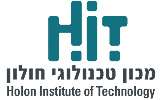Holon Institute of Technology
 | |
Former names |
Center for Technological Education Holon (CTEH) Holon Academic Institute of Technology (HAIT) |
|---|---|
| Motto | Quality and Excellence |
| Established | 1969 |
| Chairman | Mr. Cohen Pinchas (Pini) - Chairman of the Board of Trustees, Prof. Pridor Adir - Chairman of the Executive Committee |
| President | Prof. Eduard Yakubov |
| General Manager | Samuel Goldberg |
| Students | 4,263 (2017-2018) |
| Location |
Holon, Israel 32°0′51.56″N 34°46′25.75″E / 32.0143222°N 34.7738194°ECoordinates: 32°0′51.56″N 34°46′25.75″E / 32.0143222°N 34.7738194°E |
| Colors | |
| Website |
hit.ac.il/en  |
Holon Institute of Technology (HIT) (Hebrew: מכון טכנולוגי חולון), is an academic institution of higher learning in Holon, Israel. It focuses on teaching Science, Engineering, Computer Sciences, Applied Mathematics, Instructional Technologies, Design and Technology Management. HIT also deals with both theoretical and applied research and holds strong ties with the Israeli industry.[1]
History
The Holon Institute of Technology was founded in 1969 by Abraham Margalith with the support of the mayor of Holon, Pinchas Eylon. In the belief that technical vocational training was not sufficient to prepare engineers to work in Israel's developing industry, Margalith envisaged HIT as an academic center for technological education combining academic study and practical experience in industry.[2]
It opened with 100 students as the Center for Technological Education Holon (CTEH). Until 2000, it was affiliated with Tel Aviv University. In 2000, it became an independent institution called the Holon Academic Institute of Technology (HAIT) and was recognized by the Council for Higher Education in Israel as an institute of higher education.[3] In 2006, it became the Holon Institute of Technology (HIT).
The HIT single campus in the center of Holon stretches over about 50,000 square meters and includes eight buildings, two of which were constructed in the last few years. The combined area of the eight buildings is over 23,000 square meters.
Academic programs
About 4,300 students study in HIT, in the following program:[1][3]
- Electrical Engineering: B.Sc. and M.Sc. (without thesis)
- Management of Technology: B.Sc. and M.Sc. (without thesis)
- Applied Mathematics: B.Sc.
- Computer Sciences: B.Sc.
- Design:
- Interior design: B.Design
- Visual communications design: B.Design
- Integrated design: M.Design (without thesis)
The Research, Development and External Affairs Authority ("RDE Authority")
At its foundation in 2000, the Research, Development and External Relations Authority had set goal to transform HIT into a leading research institution. HIT is ranked among the 10th best Israeli academic institutions.
In the last few years, the RDE Authority has taken HIT one-step forward; singling out various research projects and raising the necessary funds needed for the research to be conducted. Such projects usually take place in collaboration with leading universities, research institutions and industries, whether located in Israel or abroad. Today, HIT boasts an impressive record of winning prestigious research grants in the fields of science, technology and design.
Relationships
To this day, HIT has over 70 academic partners, from over 26 countries:
Austria: FH Salzburg, University of Innsbruck
Brazil: IED Sao Paulo, IED Rio de Janeiro
China: East China Normal University, Nantong University
Czech Republic: Brno University of Technology, Czech Technical University Prague
Estonia: Estonian Academy of Art
France: ESAD Orleans, ESAM Design, ESAG Penninghen, EFREI School of Engineering / ESIGETEL, EPF Ecole d'Ingenieur, Strate School of Design
Germany: Weibensee Academy of Art Berlin, Fachhochschule Dortmund, University of Duisburg-Essen, Folkwang University of Arts, Hfg-Gmund, The Design Factory International, Muthesius University Of Fine Arts and Design, TH Koln, HFT Stuttgart, Trier University of Applied Sciences, HTW Dresden, Dusseldorf University of Applied Sciences
Greece: Technological Education Institute of Crete, Aristotle University of Thessaloniki
Hungary: Moholy-Nagy University of Art and Design Budapest, University of Craft and Design
India: The National Institute of Design (Paldi, Ahmedabad), Srishti School of Art, Design and Technology (Bangalore), ITTB -Industrial Design Centre (Mumbai)
Italy: Politecnico di Milano, University of L'Aquila, Rome University of Fine Arts, IED Milan/Como/Cagliari/Florence, Rome/Turin/Venice
Latvia: Rīga Stradiņš University, University of Latvia
Lithuania: Lithuanian University of Health Sciences, Kauno Kolegija University of Applied Sciences
Mexico:Universidad Nacional Autonoma de Mexico (UNAM)
Poland: SWPS University of Social Sciences and Humanities, Academy of Fine Arts in Warsaw
Portugal: Universidade de Lisboa, Instituto Politecnico de Portalegre, University of Porto
Romania: The University of Architecture and Urbanism "Ion Mincu", the "Gheorghe Asachi" Technical University of Iasi
Russia: RUDN University
Spain: Centro Universitario de Diseno (BAU), Escola Superior de Disseny (ESDI), IED Barcelona, IED Madrid
Switzerland: University of Art and Design Lausanne (ECAL)
Taiwan: Shih Chien University
The Netherlands: Design Academy Eindhoven
Ukraine: Institute of Applied Mathematics and Mechanics, National Academy of Sciences of Ukraine
United Kingdom: King's College London, University of Coventry, University of Warwick, Digital Health Institute, University of Strathclyde, Oxford-Brooks University, Kent University
U.S.A.: Sinclair Community College (Dayton, Ohio)
Uzbekistan: National University of Uzbekistan, Inha University, Tashkent State Technical University
See also
| Wikimedia Commons has media related to Holon Institute of Technology. |
References
- 1 2 "Holon Institute of Technology HIT, About". hit.ac.il. Retrieved 26 March 2014.
- ↑ Abraham Margalith (1916-1980) a man of vision and action
- 1 2 המועצה להשכלה גבוהה - מאגר מוסדות [Council for Higher Education Registry of Institutes]. che.org.il (in Hebrew). Archived from the original on 17 February 2010. Retrieved 4 August 2010.

